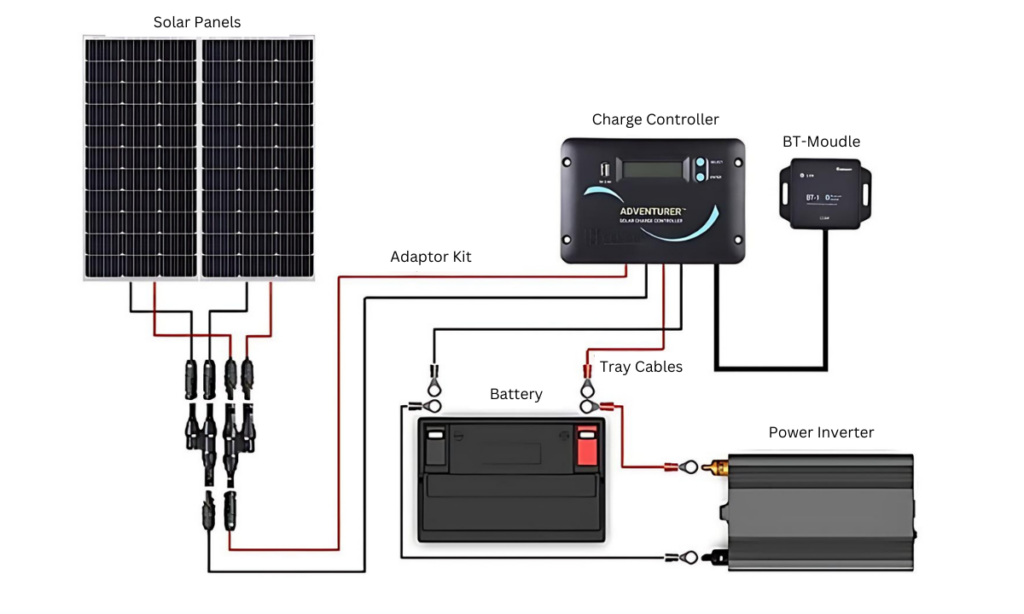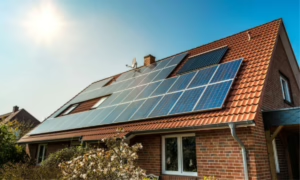Do you want to switch to solar energy but are unsure what equipment you will need? You have arrived at the right site. This article will lead you through the key steps for setting up a solar Panel system. Solar power is no longer a fad; it is a viable option for homeowners seeking to save money while lowering their carbon footprint.
Before investing in solar panels, it’s important to understand the various components that comprise a full system. Understanding the role of each component, from panels to inverters and mounting methods, is critical for efficient energy conversion, whether you use reputed solar panels.
Manufacturers like Panasonic Solar Panels or Adani Solar Panels. In conclusion, you’ll have a strong understanding of the household. solar equipment is needed for long-term energy generation.
Understanding the elements of a solar panel system

Going into the world of solar panel systems necessitates a thorough understanding of the many components. Although solar panels take center stage, there is a supporting cast of critical equipment that ensures the system functions properly. Understanding the function of each component is crucial for improving the efficiency of your home solar system. Solar panels, which collect sunlight and convert it into electricity, require additional components for maximum efficiency.
Each component, from inverters that transform absorbed energy into usable power to mounting mechanisms that hold panels in place, is crucial. This comprehensive understanding enables homeowners to make informed decisions about solar panels. Understanding the importance of each component allows you to get the most out of solar energy for your home.
Solar panels are the center of the system.

Solar panels are the heart of every domestic solar system, converting sunlight into electricity. Solar panels are composed of individual solar cells, which are typically made of silicon and designed to gather photons emitted by the sun. The absorption process releases electrons, which generate an electric current.
These panels, including well-known brands such as Panasonic Solar Panels and Adani Solar Panels, are required to generate direct current (DC) electricity. An inverter converts this power to alternating current (AC) electricity, which may subsequently be used by homes and businesses. Understanding the importance of solar panels reveals their place in the greater ecosystem of residential solar technology, emphasizing their ability to provide sustainable energy solutions.
Inverters convert DC to AC electricity.
Inverters are crucial components of any domestic solar equipment system because they convert direct current (DC) electricity generated by solar panels into alternating current (AC) power for usage in homes and businesses. AC energy drives everything from lights to electronics, therefore inverters are crucial components.
Aside from conversion, they also monitor the system’s performance, ensuring that it runs smoothly and safely. Among the possibilities, which include Enphase microinverters and Panasonic inverters, different types such as string inverters, microinverters, and power optimizers cater to diverse system sizes and energy requirements.
The selection of the proper inverter is determined by criteria such as the size of your installation and specific energy consumption habits, emphasizing the critical role these devices play in determining the efficiency and efficacy of your solar panel system.
Batteries: storing excess energy
While solar panels are excellent at generating electricity during the day, they have limits when the sun goes down or there is little sunshine. Enter batteries, which are critical components in storing excess energy produced by solar panels for later use. These batteries gather extra energy during the day, ensuring a consistent power source when sunlight is scarce, such as at night or on cloudy days.
Brands such as Livguard and Sakthi Batteries provide dependable energy storage choices for solar panel systems. Incorporating batteries not only improves energy independence, but it also minimizes reliance on the grid, encouraging the use of clean, renewable energy around the clock. This integration represents a huge step towards sustainable living, empowering consumers and organizations to embrace greener energy sources while decreasing environmental impact.
Mounting and racking systems: keeping panels in position
A dependable solar panel system is constructed around mounting and racking solutions, which are essential for secure installation and optimal panel orientation to maximize sunlight exposure. These systems, whether mounted on rooftops or ground surfaces, offer a stable and long-lasting foundation.
Their construction guarantees that the panels stay securely in place, protecting your investment from harsh weather and structural stress. Choosing the best mounting solution requires taking into account a variety of criteria, including roof type, solar panel size and weight, and local weather trends.
By carefully evaluating these factors, you can ensure a bespoke solution that not only maximizes energy output but also improves the longevity and efficiency of your solar panel installation. The quality of your mounting and racking systems not only secures your investment but also demonstrates your commitment to sustainable energy solutions, increasing the resilience and efficacy of your solar power system for years to come.
Monitoring equipment: tracking system performance
While sometimes ignored, monitoring equipment is an essential component of any solar panel system, providing insights into its performance and guaranteeing its operation. These devices provide real-time data on energy generation, consumption, and system efficiency, allowing users to discover and address issues as they arise.
Enphase Monitoring and Deif Monitoring offer advanced solutions, including remote access options for convenient monitoring from any location via cell phones or PCs. Users can use monitoring equipment to proactively modify their system’s performance, increasing energy generation and efficiency.
This proactive method not only increases the solar panel system’s reliability and endurance, but it also allows users to make more informed decisions about energy consumption and optimization.With monitoring devices in place, homeowners and businesses can confidently maximize the potential of their solar power systems while reducing downtime and improving savings.
Conclusion
Installing a solar panel system is a complex process that involves more than just purchasing solar panels. In order to convert sunlight into useful electricity, inverters, batteries, mounting systems, and monitoring equipment are necessary.Understanding the role of each element allows for more informed decision-making throughout installation.
Whether you’re researching well-known manufacturers such as Panasonic Solar Panels or looking at options for residential solar equipment, adopting a comprehensive approach guarantees that the system is effective and reliable.Adopting clean, renewable energy solutions not only lowers energy costs, but also contributes to a sustainable future. It’s time to harness the plentiful power of the sun and embark on a journey to a brighter, greener tomorrow, guided by solar panels.
Sun-AP Ecopower is one of the leading solar panel distributors in India, providing high-quality solar products nationwide.




